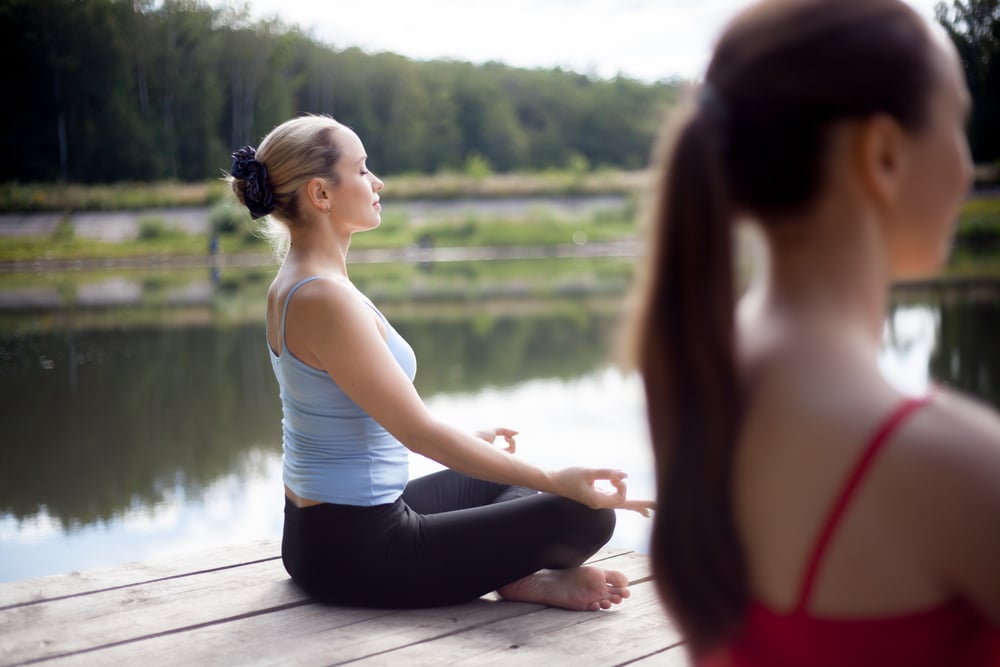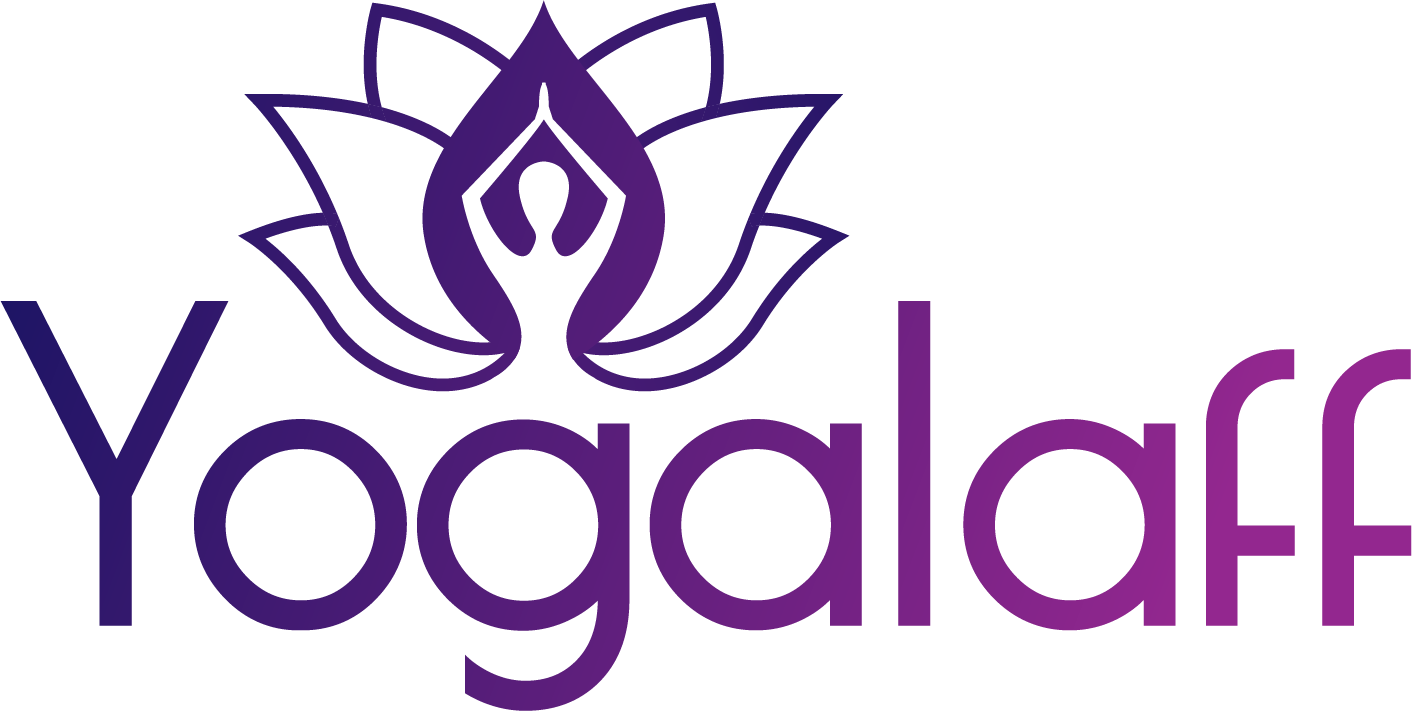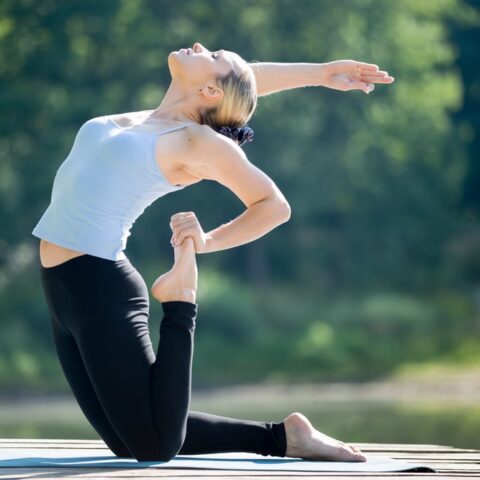Yoga provides many health benefits, but one benefit is a little more challenging to describe.
Basically, yoga makes you feel good.
After finishing a yoga class, you have probably experienced the feeling of a gigantic weight being lifted off of your shoulders.
This feeling of calmness is amazing, but most everyone knows that yoga helps you feel calm.
However, what creates this calming sensation? Have you ever wondered why yoga calms you so much?
Why Does Yoga Calm the Mind and Nerves?
 Yoga, which has been in existence for thousands of years, is a combination of mindfulness, stretching and deep controlled breathing.
Yoga, which has been in existence for thousands of years, is a combination of mindfulness, stretching and deep controlled breathing.
The primary goal of yoga is creating a feeling of connection, awareness, and harmony between your mind and body.
One of yoga’s most highly sought after benefits by both medical professionals who treat patients and yoga participants is the mindfulness, clarity, and tranquility that it promotes.
Although, some people credit this sense of calm felt during and after yoga to the ancient mysticism of the practice. Science is starting to pinpoint precisely why yoga makes you feel more peaceful, and the effect that yoga has on your mind.
The reason why yoga makes you feel so much more relaxed and calm is because of breathing techniques like diaphragmatic breathing or Ujjayi breathing.
These breathing techniques help take you out of your sympathetic nervous system and into your parasympathetic response (rest and digest) instead.
Your sympathetic nervous system is half of your autonomic nervous system (ANS). It is what triggers what is commonly referred to as the flight or flight response whenever you are under stress.
The parasympathetic nervous system is the other half of the autonomic nervous system (ANS). It promotes relaxation and healthy digestion.
Studies have shown that diaphragmatic and deep breathing, such as what is practiced in yoga, may be very effective in controlling the flight or flight response to stress.
Research has even shown that trauma-sensitive yoga may be beneficial for individuals who have post-traumatic stress disorder (PTSD), which is a mental illness that is characterized by the sympathetic nervous system being over activated.
Throughout the act of diaphragmatic breathing, your body is at ease, and that is why it is so beneficial for so many people, including individuals who have mental health issues.
Also, like most other types of exercise, it has been reported by CNN that yoga can boost the body’s production of two essential hormones for promoting feelings of calmness, good health, and happiness.
Oxytocin, which is also called “the cuddle hormone” at times, can improve your overall health and wellness. Another kind of hormone that is released while practicing yoga is endorphins.
Oxytocin and endorphins both play important roles in managing your negative emotions and physical pain.
Studies have also found that different kinds of yoga may increase the melatonin production of your body.
The National Sleep Foundation reports that this hormone helps with regulating your sleep cycle. When given that all three of those hormones are involved, it isn’t surprising that yoga creates a feeling of stillness and inner peace.
Incorporating meditation and mindfulness into yoga is another aspect of the practice that promotes the sense of calmness that it provides to so many people. Yoga’s mindfulness approach helps you take the focus away from your mind and whatever might be causing stress and shift the focus over to your body instead.
Many of us feel as if we are all consumed, mainly when we are under stress, and we exist in our thoughts only. Yoga helps to promote a balance between the body and mind.
The Washington Post has reported that, although there is debate in the research and within the mental health profession in terms of the efficacy of meditation and mindfulness, it has been shown by some studies they can have a positive impact on how the different parts of the brain light up and communicate which promote relaxation and decreases anxiety.
In 2016, SELF reported that there was a study done on meditation that discovered that it reduced levels of inflammation within the body. Many scientists believe that inflammation is the root of numerous chronic physical and mental illnesses, including disorders such as depression and anxiety.
When inflammation is effectively reduced, through exercise such as yoga, it also reduces how much stress you have to manage.
Although it can be expensive to attend yoga classes depending on the area you live in it isn’t necessary to spend a lot of money in order to experience the calming benefits that yoga provides.
There are many low-cost apps that are available, such as the Yoga Studio App, and also YouTube videos you can watch to help you start practicing yoga.
We also recommend low-impact yoga poses to help you reduce your stress. Put your legs up on a wall, then scoot your back up so it is against the wall. Next, slide your legs up so that they create a 90-degree angle – with your torso on the ground.
The posture is similar to a gentle inversion called the forward fold. It helps with regulating blood pressure, and you are left feeling wonderful overall.
You also can practice grounding, which is a yoga technique where you just walk barefoot on grass and match the pace of your walking with your breath.
Yoga Poses That Calm the Mind
Child’s Pose: Bālāsana
It’s time for a break. In the midst of Asanas, which can be challenging, Balasana, otherwise known as Child’s Pose, is a movement you can do for a quick rest.
Consciousness Seal: Chin Mudra or Jnana Mudra
How are we connected to our higher selves? Through the meditation mudra. It helps us by lifting our dull energy, calming our mind, brightening our mood and putting us in a more receptive state. We use it during Asana, Pranayama, and meditation.
Corpse Pose: Shavasana
It is a time of complete relaxation with Savasana. The pose is one of the most challenging due to the mindfulness.
Eagle Seal: Garuda Mudra
Vishnu, the lord of preservation, rides an eagle and Garuda Mudra is named after this lord. Sticking to a daily yoga practice, especially when life gets busy, takes practice, and Garuda Mudra can help.
Easy Pose: Sukhasana
The Easy Pose, or Sukhasana, may seem easy, but the name can be deceiving. In reality, Easy Pose can be challenging.
Head-to-Knee Forward Bend
Suitable for everyone, no matter your level of yoga practice, Janu Sirsasana, otherwise known as Head-to-Knee Forward Bend, also gives you a beneficial spinal twist.
Legs-Up-the-Wall Pose
Viparita Karani or Legs-Up-the-Wall pose is so powerful that most yogis believe it’s a cure-all for that ails you.
Reclining Bound Angle Pose
No matter the level of groin and hip resistance, Supta Baddha Konasana or Reclining Bound Angle Pose is a classic restorative posture.
Reclining Hand-to-Big-Toe Pose
Are you suffering from an aching back or tight hamstrings? Supta Padangusthasana or Reclining Hand-to-Big-Toe Pose could be the cure.
Reclining Hero Pose
Supta Virasana or Reclining Hero Pose is Virasana reclined. The stretch you receive in your thighs and ankles gets bumped up a notch.
Seated Forward Bend
Paschimottanasana or Seated Forward Bend helps your hamstrings and focuses your mind.
Standing Forward Bend
Uttanasana or Standing Forward Bend also helps your hamstrings and focuses your mind.
Standing Half Forward Bend
Ardha Uttanasana or Standing Half Forward Bend involves lengthening the front body before moving into a forward fold.
Wide-Legged Forward Bend
Prasarita Padottanasana or Wide-Legged Forward Bend helps to increase flexibility significantly.
Ultimately yoga teaches you how to teaches in the present instead of being a slave to your thoughts. That might sound ambitious, but when you focus your breath in the here an now, it connects you with the now.
Although yoga and meditation might not be well-suited for everyone, according to science it can definitely be a useful therapeutic tool for individuals who are wanting to de-stress, unwind, and provide their lives with more calmness.

